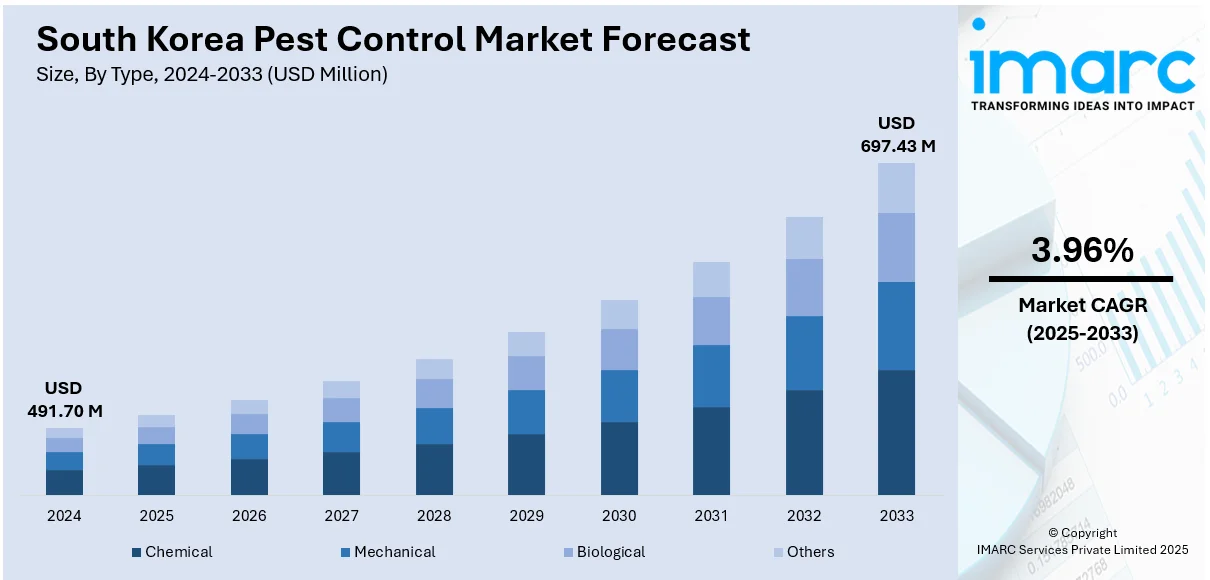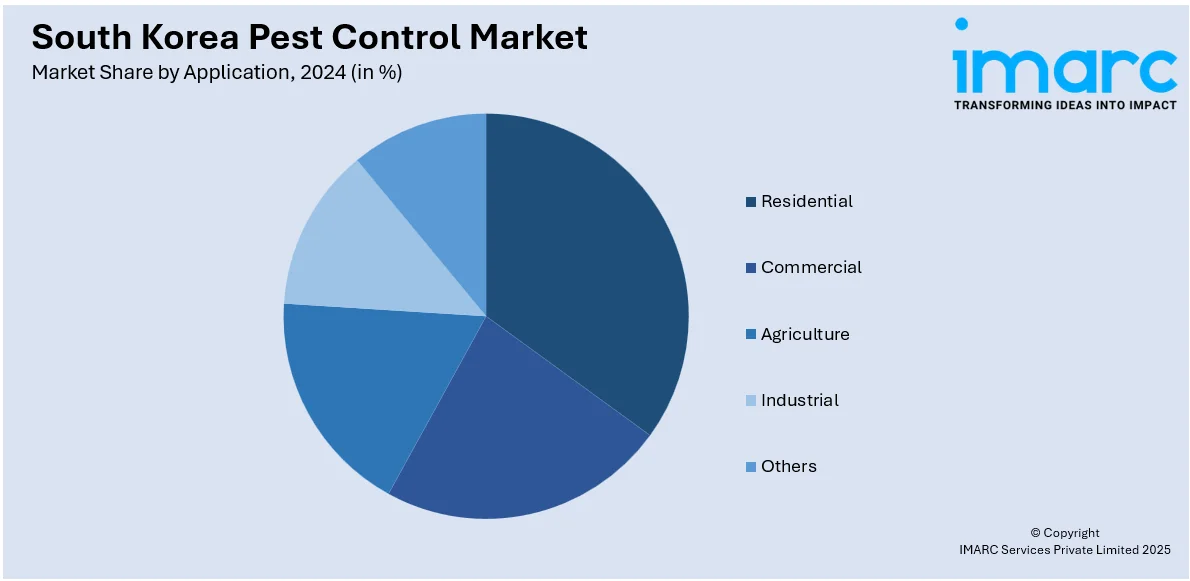
South Korea Pest Control Market Size, Share, Trends and Forecast by Type, Pest Type, Application, and Region, 2025-2033
South Korea Pest Control Market Overview:
The South Korea pest control market size reached USD 491.70 Million in 2024. Looking forward, the market is expected to reach USD 697.43 Million by 2033, exhibiting a growth rate (CAGR) of 3.96% during 2025-2033. The market is expanding due to increased urbanization, growing awareness about health and hygiene, and stricter regulations across commercial and residential sectors. Demand for eco-friendly and integrated pest management solutions is also rising, driven by environmental and safety concerns. These evolving dynamics are contributing to the growth of the South Korea pest control market share.
|
Report Attribute
|
Key Statistics
|
|---|---|
|
Base Year
|
2024 |
|
Forecast Years
|
2025-2033
|
|
Historical Years
|
2019-2024
|
| Market Size in 2024 | USD 491.70 Million |
| Market Forecast in 2033 | USD 697.43 Million |
| Market Growth Rate 2025-2033 | 3.96% |
South Korea Pest Control Market Trends:
Rising Health and Hygiene Awareness
Growing public concern over pest-related health risks, such as allergies, food contamination, and vector-borne diseases, is significantly driving demand for pest control services in South Korea. Increased consumer education, along with heightened hygiene expectations in homes, schools, hospitals, and restaurants, has made pest prevention a priority. This is particularly critical in the foodservice and healthcare industries, where regulatory compliance and safety standards require proactive pest management. Households are also becoming more willing to invest in professional services to maintain clean and pest-free living environments. As a result, the market is experiencing steady growth, fueled by consumer behavior shifting toward regular pest inspections and preventive treatments rather than reactive responses, reinforcing the perception of pest control as essential to everyday public health.

To get more information on this market, Request Sample
Urbanization and Growth of Commercial Infrastructure
Rapid urban development and expansion of commercial spaces, such as office buildings, manufacturing facilities, retail centers, and hospitality venues, are creating favorable conditions for pest infestations, driving the South Korea pet control market growth. High-density environments often lead to improper waste management and limited ventilation, making them ideal for rodents, cockroaches, and insects to thrive. As South Korea’s urban footprint grows, so does the complexity of pest control needs, particularly in multi-use buildings and industrial complexes. Businesses are increasingly outsourcing to professional pest control providers to comply with hygiene regulations, protect reputations, and ensure uninterrupted operations. The need for scalable and customized pest management solutions across urban sectors has become a key driver, contributing to the sustained demand for integrated pest control services nationwide.
Regulatory Enforcement and Shift Toward Eco-Friendly Solutions
The South Korean government has implemented stricter environmental and safety regulations concerning pesticide usage, driving a transition toward greener pest control methods. Traditional chemical solutions are increasingly restricted due to their harmful effects on ecosystems and non-target organisms. This regulatory pressure, combined with growing consumer preference for sustainable practices, is fueling innovation in biological controls, non-toxic repellents, and integrated pest management (IPM) techniques. Pest control companies are now investing in R&D to meet these evolving standards while maintaining effectiveness. Additionally, public institutions and commercial entities are adopting environmentally responsible protocols to align with corporate sustainability goals. This shift is not only modernizing the industry but also expanding the market by appealing to health-conscious and eco-aware consumers.
South Korea Pest Control Market Segmentation:
IMARC Group provides an analysis of the key trends in each segment of the market, along with forecasts at the country and regional levels for 2025-2033. Our report has categorized the market based on type, pest type, and application.
Type Insights:
- Chemical
- Mechanical
- Biological
- Others
The report has provided a detailed breakup and analysis of the market based on the type. This includes chemical, mechanical, biological, and others.
Pest Type Insights:
- Insects
- Termites
- Rodents
- Others
A detailed breakup and analysis of the market based on the pest type have also been provided in the report. This includes insects, termites, rodents, and others.
Application Insights:

- Residential
- Commercial
- Agriculture
- Industrial
- Others
The report has provided a detailed breakup and analysis of the market based on the application. This includes residential, commercial, agriculture, industrial, and others.
Regional Insights:
- Seoul Capital Area
- Yeongnam (Southeastern Region)
- Honam (Southwestern Region)
- Hoseo (Central Region)
- Others
The report has also provided a comprehensive analysis of all the major regional markets, which include Seoul Capital Area, Yeongnam (Southeastern Region), Honam (Southwestern Region), Hoseo (Central Region), and others.
Competitive Landscape:
The market research report has also provided a comprehensive analysis of the competitive landscape. Competitive analysis such as market structure, key player positioning, top winning strategies, competitive dashboard, and company evaluation quadrant has been covered in the report. Also, detailed profiles of all major companies have been provided.
South Korea Pest Control Market Report Coverage:
| Report Features | Details |
|---|---|
| Base Year of the Analysis | 2024 |
| Historical Period | 2019-2024 |
| Forecast Period | 2025-2033 |
| Units | Million USD |
| Scope of the Report |
Exploration of Historical Trends and Market Outlook, Industry Catalysts and Challenges, Segment-Wise Historical and Future Market Assessment:
|
| Types Covered | Chemical, Mechanical, Biological, Others |
| Pest Types Covered | Insects, Termites, Rodents, Others |
| Applications Covered | Residential, Commercial, Agriculture, Industrial, Others |
| Regions Covered | Seoul Capital Area, Yeongnam (Southeastern Region), Honam (Southwestern Region), Hoseo (Central Region), Others |
| Customization Scope | 10% Free Customization |
| Post-Sale Analyst Support | 10-12 Weeks |
| Delivery Format | PDF and Excel through Email (We can also provide the editable version of the report in PPT/Word format on special request) |
Key Questions Answered in This Report:
- How has the South Korea pest control market performed so far and how will it perform in the coming years?
- What is the breakup of the South Korea pest control market on the basis of type?
- What is the breakup of the South Korea pest control market on the basis of pest type?
- What is the breakup of the South Korea pest control market on the basis of application?
- What is the breakup of the South Korea pest control market on the basis of region?
- What are the various stages in the value chain of the South Korea pest control market?
- What are the key driving factors and challenges in the South Korea pest control market?
- What is the structure of the South Korea pest control market and who are the key players?
- What is the degree of competition in the South Korea pest control market?
Key Benefits for Stakeholders:
- IMARC’s industry report offers a comprehensive quantitative analysis of various market segments, historical and current market trends, market forecasts, and dynamics of the South Korea pest control market from 2019-2033.
- The research report provides the latest information on the market drivers, challenges, and opportunities in the South Korea pest control market.
- Porter's five forces analysis assist stakeholders in assessing the impact of new entrants, competitive rivalry, supplier power, buyer power, and the threat of substitution. It helps stakeholders to analyze the level of competition within the South Korea pest control industry and its attractiveness.
- Competitive landscape allows stakeholders to understand their competitive environment and provides an insight into the current positions of key players in the market.
Need more help?
- Speak to our experienced analysts for insights on the current market scenarios.
- Include additional segments and countries to customize the report as per your requirement.
- Gain an unparalleled competitive advantage in your domain by understanding how to utilize the report and positively impacting your operations and revenue.
- For further assistance, please connect with our analysts.
 Request Customization
Request Customization
 Speak to an Analyst
Speak to an Analyst
 Request Brochure
Request Brochure
 Inquire Before Buying
Inquire Before Buying




.webp)




.webp)












